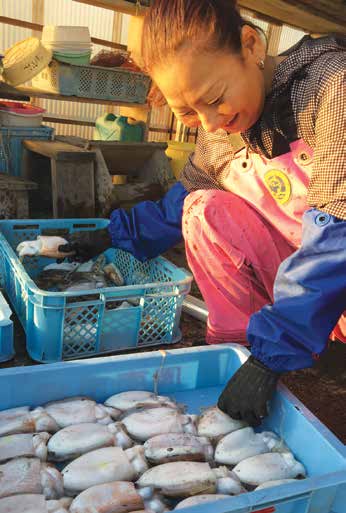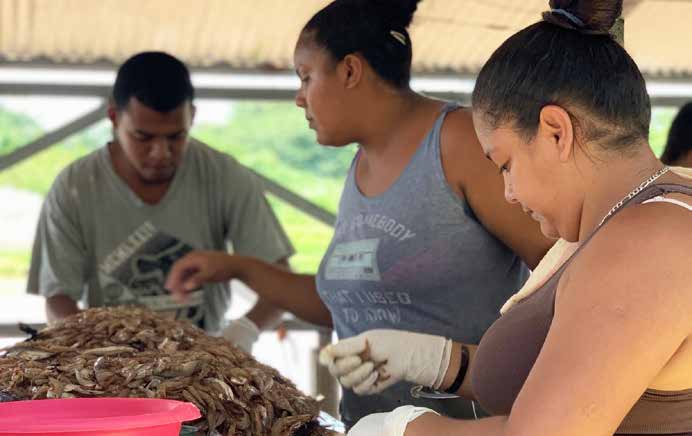
The gallery contains a collection of photographs published in issues of the SAMUDRA Report and the Yemaya Newsletter, as also other ICSF publications, workshops and meetings over the years. Also to be found are more general images of fishing and fishworkers in action across the world. There are about 10,000 photos from 64 countries. The photo database is searchable by caption, country and photographer. All images are free for download, though users are requested to credit the photos to ICSF and the respective photographer.

The ahotor oven is energy efficient and helps women fish processors reduce the quantity of firewood in smoking fish. It also improves quality of smoked fish.
Photo credit: Emelia Abaka Edu

A woman working with dry fish in Cox’s Bazar, Bangladesh. However, the work done by women and their contribution to the economy is largely unrecognized and women remain largely absent in decision making for the management and development of the sector.
Photo credit: MD.Maksudur Rahman

Woman in a dry fish plant at Cox’s Bazar, Bangladesh. Around 70 per cent of women fishers are involved in different support activities, including drying fish, and net making. The low involvement of women in income generation hinders their empowerment and financial self-reliance in Bangladesh society.
Photo credit: Din M Shibly

A group photo of AKTEA meeting, Brussel, Belgium. Participants from countries without national organisations decided it was time to act at the national or regional levels to establish their own representation.
Photo credit: AKTEA

AKTEA meeting, Brussels, Belgium, 26 February 2020. This meeting, which was attended by 40 women from across nine European Union (EU) Member States, served to initiate the revival and re-launch of AKTEA.
Photo credit: AKTEA

Women dominate the seafood processing sector, converting the catch into marketable and consumable products. Here a Heiltsuk woman grades herring spawn-on-kelp for international export at Bella Bella’s fish processing plant in the Traditional Territory of the Heiltsuk Nation, Canada.
Photo credit: Sarah Harper

Gleaning in the reef flats of Danajon Bank (Philippines), an activity often overlooked in fisheries data collection and undervalued in considering the food and livelihood impacts of small-scale fisheries.
Photo credit: Danika Kleiber

Cambodian women migrant fishworkers sorting fish in Thailand. In Southeast Asia, there is very little organizing among fishers, probably because many fishers in this region combine farming and fishing and there are few full-time fishers.
Photo credit: Kyoko Kusakabe

Fisher woman, Japan. Women in Japanese coastal communities doesn’t have full membership rights because of the Japanese law and the practice of ‘one member per household’, with membership traditionally reserved for men.
Photo credit: Kumi Soejima

International women day marching in Guinea Bissau on 8 March 2015. The increasing involvement of women in the defining of CAOPA advocacy priorities and in its actions has contributed to show that artisanal fishing communities, particularly women, are innovators and active stakeholder
Photo credit: CFFA

Earnings of women in activities linked to artisanal fishing are generally very low. In most cases, women do not perceive significant changes in their income irrespective of whether the times are bad, regular and good.
Photo credit: CoopeSoliDar R.L

In the small-scale artisanal fishing chain, the majority of women (62 per cent) were between 31 and 60 years of age. However, most of the work they do is not covered by decent retirement options.
Photo credit: CoopeSoliDar R.L.

A dip in livelihood of women fishvendors in Karnataka, India. Most of the government schemes and compensation packages are meant for fishers registered with fishing cooperatives. A large number of women involved in fish vending activities are not registered.
Photo credit: Shivakumar Magada

Minister for Women, Hon Mereseini Vuniwaqa speaking at the Opening of the Women in Fisheries Forum. Given the positive feedback received from participants, the Women in Fisheries Forum is likely to become an annual feature.
Photo credit: Wildlife Conservation Society

Participants at the Women in Fisheries Forum with their copies of the gender stock take report that was launched. At the forum, success stories were shared by women fishers from Ra who run a very lucrative trade in sea-grapes.
Photo credit: Wildlife Conservation Society